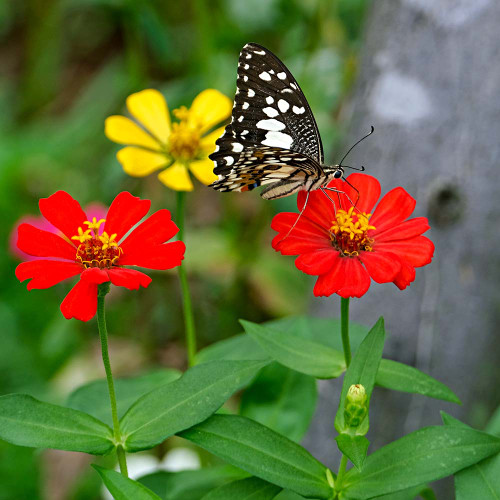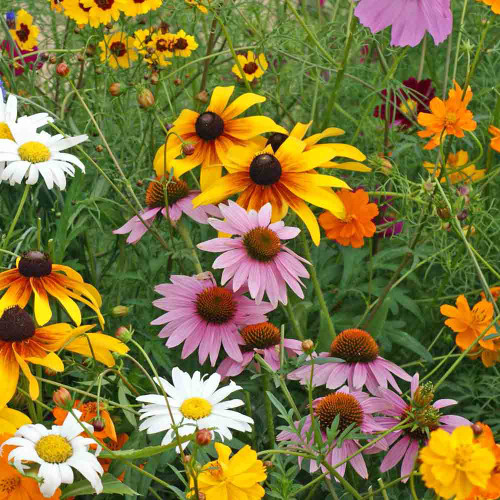Description
Dahlia Flowered Zinnia Seed Mix - Grow Blooms Like Living Sculptures
Invite a dazzling, summer-long parade of pollinators – including bees, hummingbirds, and especially Monarch butterflies, whose populations truly need our support – to your garden with the easy-to-grow beauty of Dahlia Flowered Zinnias. These reliable annuals deliver spectacular, long-lasting color with straightforward care, thriving even through summer heat. Their striking, dahlia-like form first caught our eye years ago during a visit to the Denver Botanical Gardens – seeing the pollinators flocking to them cemented their place in our collection for gardeners seeking both vibrant beauty and ecological value in beds, borders, and cutting gardens.
Details
A cherished staple known to generations of gardeners, Dahlia Flowered Zinnias bring spectacular color and form to the summer garden. These adaptable plants grow as upright, bushy annuals, completing their lifecycle in one season. The popular Dahlia-flowered varieties typically reach 1 to 4 feet tall with a spread of about 1 foot. Their sturdy, branching stems feature opposite, ovate to lance-shaped leaves that often feel slightly coarse or sandpapery.
The impressive flower head is the defining feature – a large, composite bloom. "Dahlia Flowered" refers to the fully double form, where multiple, overlapping rows of broad ray florets create a lush, layered look, often measuring 3 to 6 inches across. These blooms offer an unusually wide range of colors, including reds, pinks, oranges, yellows, purples, lavenders, whites, and even greens. While visually stunning, these flowers generally lack significant fragrance. Zinnias perform well as annuals across USDA Zones 2-11 and typically begin blooming 80-95 days from seed.
History
Native to Mexico's grasslands, the wild ancestors of today's garden zinnias were considered somewhat scraggly by early Spanish explorers. The genus Zinnia was named in honor of Johann Gottfried Zinn, a German botanist and anatomist who made significant contributions to understanding the human eye and the field of botany. In addition to his pioneering eye research, Zinn became the director of the University Botanical Garden in Göttingen at 26, expanding the garden's collection, introducing foreign plant species, and documenting their characteristics.
The plant's transformation began after Zinnia elegans was introduced to Europe around 1796, with double-flowered forms appearing by 1858. The truly spectacular Dahlia Flowered type gained prominence in the 1920s, thanks mainly to Bodger Seeds Ltd. in California. John Bodger discovered a natural mutation with exceptionally large, multi-petaled flowers on robust plants within their 'Mammoth' zinnia fields. Developed and introduced as the 'California Giants' series, this strain popularized the large, fully double form. This lineage solidified the appeal of these blooms, ensuring their place as cherished open-pollinated heirlooms.
Uses
Dahlia Flowered Zinnias are prized primarily for their notable ornamental value and as superb cut flowers. Their brilliant, diverse colors and long blooming season provide an eye-catching impact in annual beds, mixed borders, and mass plantings. With large blooms on long, sturdy stems, they are invaluable for cutting gardens, offering an abundant supply for colorful indoor arrangements with a vase life that often lasts 7 to 10 days.
Beyond their visual appeal, zinnias are powerful magnets for pollinators, reliably attracting butterflies, including Monarchs, bees, and hummingbirds. They also draw various beneficial predatory insects (like ladybugs, lacewings, syrphid flies, parasitic wasps) that help control common garden pests naturally, contributing significantly to a healthy garden. Importantly, zinnias are considered non-toxic to pets and people. Their adaptability also makes them suitable for container culture (choose an appropriate pot size and ensure excellent drainage).
Companion Planting
The main companion benefit zinnias offer is attracting beneficial insects and pollinators, which can aid nearby vegetable crops like tomatoes (as shown in studies) or enhance fruit set. Ensure good air circulation between zinnias and companions.
While not directly antagonistic, avoid planting extremely tall zinnia varieties where they might excessively shade sun-loving neighbors like peppers or basil.
Planting and Growing Tips
As warm-weather annuals, Dahlia Flowered Zinnias need full sun (at least 6-8 hours daily) to perform their best. They perform best in rich, fertile soil with excellent drainage, preferring a pH from slightly acidic to neutral. Amending beds generously with compost before planting is highly beneficial. Direct sowing after all frost danger, when the soil is warm (70-80°F ideal), is recommended. Sow seeds shallowly, about ¼ inch deep, spacing 12-18 inches, thinning seedlings carefully if needed. Germination is usually rapid (4-9 days) in warm soil.
While drought-tolerant once established, consistent moisture yields the best blooms. Water deeply at the soil level (approx. 1 inch/week) to keep foliage dry. Zinnias are relatively light feeders; avoid excessive nitrogen. A light feeding with a balanced fertilizer occasionally may help, especially in containers. Pinching growing tips when plants are 8-12 inches tall encourages bushier growth. Install support early for tall varieties prone to lodging. Mulch helps conserve moisture and suppress weeds. Keep the area weeded, especially when plants are young.
Potential Challenge: Powdery Mildew - Zinnia elegans varieties are susceptible to powdery mildew, especially in humid conditions or with poor airflow. Prevention is key: prioritize full sun, proper spacing for air circulation, and watering at the soil base. If mildew appears, remove affected leaves promptly. Effective organic options include neem oil or potassium bicarbonate sprays. Another research-backed approach is a diluted milk spray; studies by researchers like Dr. Wagner Bettiol (and replicated by growers) found milk surprisingly effective against powdery mildew, sometimes even outperforming chemical fungicides, potentially offering foliar nutrition benefits as well. You can learn more about this technique in our article, Milk and Molasses – Magic for Your Garden. Ensure thorough leaf coverage if applying any spray treatment.
Harvesting Tips
For the longest vase life as cut flowers, harvest zinnias when blooms are nearly or fully open but before pollen is visible in the center disk. Use the "shake test": gently shake the stem below the flower; if it's stiff and doesn't wobble excessively, it's ready. Cut long stems in the cool morning, strip lower leaves, and place immediately in water with floral preservative (expect 7-10 days). Regular cutting or deadheading spent blooms is crucial for encouraging continuous flowering all season long, as it prevents the plant from focusing on seed production.
Learn More
From the soil to the seed to the food you eat - we'll help you grow your best garden!

















